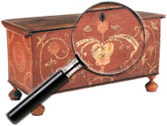Magic Lanterns & Slides
The magic lantern is an early form of slide projector using a focusing lens and light source to project an image. The images are on glass and either hand-painted, lithographed or photographic.
The earliest forms of magic lanterns appeared in the 1400′s and through development they were transformed into the lanterns we recognise today. Because of their age, unlike other forms of collectible photographica, it is impossible to say who was the inventor of the magic lantern.
A work published in 1646 by a German Jesuit priest, Arthanasius Kircher, entitled Ars Magna Lucis et Umbrae contains the first mention of the use of a lens to focus the projected image. Until this point no lens had been used and the images projected were very basic with little clarity. The work also suggested the use of sunlight or a candle to aid illumination. From the early 1650′s European scientists began to develop new forms of lanterns as part of their scientific experiments. Two of these pioneers were Christiaan Huygens from Holland and Thomas Rasmussen Walgensten from Denmark. Both men made further advances in the lantern development and Walgensten coined the phrase Lanterna Magica. He also saw an opportunity to make money from producing and selling lanterns, as a form of entertainment and education.
John Reeves, an optician working in London in the early 1660′s, began producing and retailing magic lanterns. One of Reeves customers was the diarist Samuel Pepys who made mention of his lantern in his famous diary.
By the 18th century vast numbers of people were developing and producing magic lanterns along with all of the sundries that were associated with them. Up until this point the lantern shows were limited but as the methods and quality of production moved on lanternists could give displays to much larger audiences. This in turn gave way to the professional showman. Horror shows were extremely popular and these became known as Phantasmagoria. These new shows set out to scare their audiences with their ghostly and devil-like images. Developments in this area included mobile lanterns to create the illusion of movement and the use of a screen to hide the lanternist to add to the mystery.
By the 19th century many more showmen had taken up the profession and were travelling around giving lantern shows to the eager public. Members of this later group were called Galantee or Savoyards and their shows covered many subjects, amongst the most popular were Biblical and current event themes. During this time improved manufacturing methods led to the mass production of magic lanterns. This meant that lantern shows could be given in your own home, leading to the decline of the travelling shows. In order to entice the public back to the professional shows a new type of lanternist emerged, known as the professor. He would give lectures making use of expensive lanterns and slides, some of which were animated and were not available readily to the general public. These lanterns and slides would have been beyond the means of the average person.
By the late nineteenth century new forms of lighting such as the arclight allowed lanternists to produce even more elaborate shows to even bigger audiences. Later developments included the Bi-unial or double lantern (also called a stereopticon). Using the stereopticon a lanternist could also show slides that appear to dissolve as it had two separate optical systems. Triple lens or Tri-Unial projectors were also available enabling the skilled lanternists to provide even more elaborate effects. At the same time the more basic lantern also improved due to the use of mineral oil lamps. This led to a greater use of lantern shows for educational purposes by smaller groups such as churches. A plethora of lanterns and slides covering a wide range of events and subjects were produced by various companies in the last half of the 19th century, including a great variety of toy lanterns and slides produced for the home market.
The earliest forms of magic lantern slides were hand-painted on glass, then in 1850 William and Frederick Langenheim started to produce photographic images on glass slides. The Langenheim brothers called their invention the Hyalotype. Photographic lantern slides during this period were black and white but these were often hand-tinted to produce a coloured image. The Lumeire Brothers early experiments with color photography eventually led to colored lantern slides in the 20th century.
The most famous American magic lantern artist was Joseph Boggs Beale (1841 to 1926). Beale created magnificent hand-painted slides, including Halloween slides and a series of Christmas themed slides such as The Night Before Christmas. He also produced sets of slides that told a complete story with a great amount of detail. His work was incredibly popular and a vast number of his slides were copied and distributed to lanternists and individuals.
Prices for magic lanterns can range from under 100 dollars for a very basic model to in excess of several thousand dollars for superior quality lantern by a well known maker. Much the same as the lanterns themselves the slides can range in price greatly from as little as a couple of dollars to many hundreds of dollars for a rare example. The condition will also influence prices collectors are willing to pay. In certain cases a rare lantern, or indeed slide, in poor condition will still command a higher price, but in the main condition is a key factor in pricing. Collectors have their own views on what they want in an image and this too can influence the price they are willing to pay.
Reference note by p4A.com Contributing Editor Robert M. Ginns.
